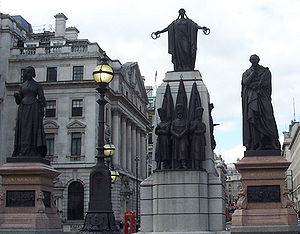- Crimean War Memorial
-
Crimean War Memorial United Kingdom 
For Victory in the Crimean War Unveiled 1915 Location 51°30′26.46″N 0°7′57.71″W / 51.50735°N 0.1326972°WCoordinates: 51°30′26.46″N 0°7′57.71″W / 51.50735°N 0.1326972°W near London, United Kingdom Designed by John Henry Foley and Arthur George Walker CRIMEA The Crimean War Memorial is located on Waterloo Place, at the junction of Lower Regent Street and Pall Mall in London, about a quarter of the way from the Duke of York Column to Piccadilly Circus.[1]
Originally it was unveiled in 1861, consisting of the statues of three Guards Men, with the female allegorical figure referred to as Honour. It was cast in bronze from the cannons captured at the siege of Sevastopol. The sculptor was John Bell.[2]
On the front, by the statues of the Guardsmen are two plaques. The uppermost states:
The Guards' Memorial was pulled down in the year of our lord 1914 and was re-erected 30 feet north in order to permit the erection of the Florence Nightingale and Sidney Herbert statues.
The Lower one states:
The foundation stone of the Guards' Memorial was laid in the year of our lord 1861 by Margaret Johanna Bell.
On the back facade of the monuments, facing the road up to Piccadilly is another plaque, a shield surrounded by foliage and mounted on guns, this reads:
To the memory of 2152 Officers, Non-Com. Officers and Privates of the BRIGADE OF GUARDS who fell during the war with Russian in 1854-56. Erected by their Comrades.
In 1914 it was pulled down and moved to make room for the statues of Florence Nightingale and Sidney Herbert - Secretary at War at the War Office during the War. It is only then that the allegorical figure is referred to as Victory. The sculpture of Florence Nightingale was by Arthur George Walker,[3] and the sculpture of Sidney Herbert was by John Henry Foley.[4]
References
Categories:- Military memorials in London
- Crimean War
- Florence Nightingale
- Nursing monuments and memorials
- London building and structure stubs
Wikimedia Foundation. 2010.


